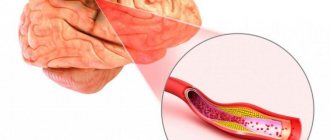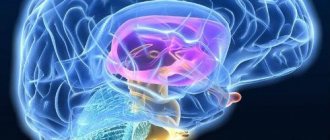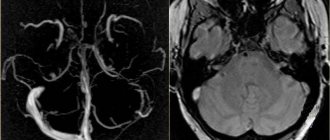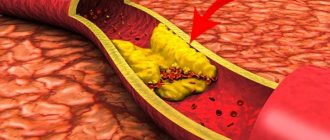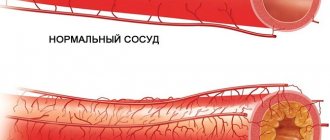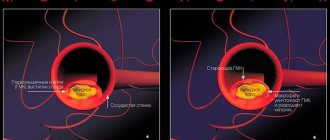Atherosclerosis of cerebral vessels is a disease that occurs due to the formation of atherosclerotic plaques in them and in most cases is a harbinger of a stroke. At the initial stages of development, this disease does not “give itself away” in any way, which is its main danger. When the lumen of the arteries decreases, patients may feel dizzy, as well as extraneous noise in the ears and head.
Symptoms and signs
The symptoms are very similar to those of discirculatory encephalopathy (sometimes even these terms are used as synonyms, although this is incorrect):
- Headache.
- Dizziness.
- Memory loss.
- Mood swings.
- Sleep disorders.
- Noise in the head.
- Throwing to the sides while walking.
- Nausea, etc.
Signs may also include decreased hearing, decreased vision after excluding pathology by an ENT doctor and an ophthalmologist.
Symptoms of cerebral atherosclerosis
The clinical manifestations of atherosclerosis are quite diverse, and not all of them appear immediately, in the first stages. In general, the following symptoms of this disease can be identified:
- headaches of varying intensity and duration;
- slowness of movements;
- excessive excitability, suspicion and anxiety;
- unclear speech;
- impaired coordination of movements;
- choking while eating;
- sleep problems (frequent awakenings, nightmares, insomnia).
Symptoms of atherosclerosis appear in different people with varying intensity, but they become most severe when overworked. Gradually, the pain begins to be felt by the person on a constant basis and, moreover, is accompanied by dizziness. Ultimately, a person simply gets used to such sensations. The very severity of the disease depends on the degree of blockage of blood vessels and the level of their damage.
Diagnostics
In order for the treatment of the disease to proceed successfully, it is necessary to carry out a whole list of various measures. First of all, you need to determine the stage of treatment. For this purpose, specialists use the following ultrasound research methods:
- X-ray examination of cerebral vessels;
- transcranial dopplerography;
- Ultrasound of extracranial vessels.
If a person is often bothered by headaches and tinnitus, then he should undergo an MRI of the brain, which uses modern high-quality equipment.
Prevention
To effectively prevent atherosclerosis, a specialist will prescribe a balanced diet, in which you will need to reduce the consumption of foods containing large amounts of cholesterol. The patient is also recommended to eat more onions and garlic, strawberry leaves, seaweed and lemon balm. In addition, disease prevention involves increasing physical activity (cycling, swimming or walking).
Diagnostics
Diagnosis of the disease is based on vascular studies (REG, ultrasound, angiography), neuroimaging techniques (MRI, MSCT). According to research data, the presence of plaques and calcifications in the vessels is determined. It is also possible to identify the presence of areas of turbulent (vortex) blood flow.
Sometimes the diagnosis is made based on a biochemical blood test for cholesterol and its fractions with the calculation of the atherogenic index. In the presence of a high atherogenicity index (above 4) and a confirmed fact of long-term dyslipidemic changes (performing dynamic tests), it is possible to diagnose cerebral atherosclerosis without additional examination.
Atherosclerosis - who gets sick more often?
Most often, people over 40 years old suffer from atherosclerosis. However, atherosclerotic changes in the arteries can appear after 20 years. With age, their number increases under the influence of many factors (lifestyle, bad habits, development of chronic diseases), which leads to the occurrence of the disease.
The exact causes of atherosclerosis have not been established by science. However, the development of the disease can be triggered by:
- lack of physical activity;
- smoking and drinking alcohol;
- unhealthy and unbalanced diet;
- heart and vascular diseases;
- age-related changes.
In most cases, atherosclerosis is asymptomatic until the artery becomes pathologically narrowed or blocked.
Treatment
Therapy of the disease is carried out at the junction of general practitioners and neurologists. Drugs that normalize lipid metabolism are used. More often than others, statins are used (atorvastatin, simvastatin, rosuvostatin, etc.) under the mandatory control of many biochemical parameters (ALT, AST, creatinine, in fact, the level and ratio of cholesterol fractions). The dosage and duration of taking the drugs is selected individually.
If there is stenosis of the arteries of the head or neck of more than 70%, severe symptoms, or the presence of episodes of transient ischemic attacks, surgical intervention is possible. Plaques are removed and arteries are stented.
Atherosclerosis of the aorta
Atherosclerosis of the aorta is a disease in which atherosclerotic plaques appear on the inner walls of the aorta. As a result, the walls of the aorta lose their elasticity and the blood supply to the internal organs is disrupted. Often the disease is asymptomatic, so it is diagnosed only after ultrasound or other studies. If the plaques are localized in the thoracic aorta, blood circulation to the brain is disrupted, and blood circulation to the abdominal region is impaired - decreased appetite, flatulence, constipation and numbness of the lower extremities are observed. If the coronary arteries are damaged, pressing pain behind the sternum may occur.
Prevention
All patients with cerebral atherosclerosis need a diet. The diet requires strict control of the intake of animal fats (butter, lard, fatty meat, etc.), sugar (confectionery, sugar, sweet drinks, etc.), offal and semi-finished products. Whenever possible, such foods are excluded from the diet or significantly limited. Preference is given to seafood, vegetables, and cereals.
Prevention also involves regular preventive examinations and medical examinations with the possibility of timely detection of lipid metabolism disorders and the prescription of medications. To prevent possible consequences of the disease, it is important to prescribe adequate antihypertensive therapy, because it is the combination of atherosclerosis and high blood pressure levels that most often lead to conditions such as transient ischemic attacks and ischemic strokes.
Two hypotheses
The assumption that inflammation and infection are involved in the development of atherosclerosis was made back in the 1990s, and in recent years the amount of evidence supporting this hypothesis has been steadily growing. It has been proven that local inflammation in the cells of medium and large arteries is a specific immune reaction (activation of T lymphocytes), accompanied by a nonspecific increase in monocytes
- one of the types of leukocytes, blood cells capable of phagocytosis, which are released during inflammatory reactions.
Using electron microscopy between vascular cells (in areas of future sclerotic plaques), it was possible to detect macrophages
- relatively large blood cells capable of actively capturing and digesting foreign or toxic objects. The accumulation of macrophages is one of the early morphological signs of the disease. The molecular mechanisms of macrophage adhesion to the inner surface of blood vessels are similar to those observed during acute inflammation. Perhaps this is one of the early molecular mechanisms of plaque formation.
A large number of developing atherosclerotic plaques include formations consisting of macrophages, lymphocytes and smooth muscle cells, usually surrounded by fibrous tissue. Platelets accumulate around the plaque, which is accompanied by damage to vascular cells. All such relationships between blood cells and vascular endothelium are currently being intensively studied.
Liver cells, both during inflammation and atherosclerosis, increase the synthesis and secretion into the blood of special inflammatory proteins (C-reactive protein, lipoprotein, fibrinogen). Clinically, the inflammation syndrome and sclerotic process can continue for a long time, with periods of exacerbation alternating with periods of remission, i.e., they consist of the same functional reactions. This is why elevated levels of fibrinogen, C-reactive protein, and erythrocyte sedimentation rate are thought to be indicators of cardiovascular disease risk.
The infectious theory of atherosclerosis can also be confirmed by the fact of detection of some microorganisms, such as Helicobacter pylori
,
Chlamydia pneumoniae,
etc., in atherosclerotic plaque and in the blood. Developing the hypothesis about the infectious etiology of atherosclerosis, Italian scientists suggested that there may be a connection between coronary heart disease and the hepatitis C virus.
Today it is recognized that the leading place in the development of endothelial dysfunction and, possibly, atherosclerosis, is a violation of the synthesis of nitric oxide (NO). It is believed that it is due to the action of NO that relaxation of blood vessels occurs in response to an external stimulus. (At least, the use of L-arginine, the substrate from which nitric oxide is formed, in the treatment of atherosclerosis led to an improvement in vascular function.) A decrease in the level of NO in the area of atherosclerotic plaques contributes to persistent vasospasm in the area of atherosclerotic lesions.
Interestingly, impaired vascular relaxation is recorded not only in patients already suffering from atherosclerosis, but even in those who are predisposed to it, as well as in smokers.
"Bad" and "good" cholesterol
This complex organic compound belongs to fats, more specifically to fatty alcohols. Cholesterol is involved in various processes in our body, for example, it is a kind of building material for cell walls, and is also part of hormones and vitamins.
For the most part (about 70%) cholesterol is produced in the liver, the remaining amount enters the body through food. There is no cholesterol in the body in its “pure form”, since it is part of complex compounds of fats and protein - lipoproteins (lipoproteins).
Atherogenic (promoting the development of atherosclerosis) are low-density lipoproteins (LDL), containing up to 45% cholesterol. Low-density lipoproteins transport cholesterol from the liver to cells, where it participates in the synthesis of cell membranes. LDL and VLDL cholesterol are the main risk factors for the development of atherosclerosis, since these compounds easily pass into the vessel wall and form an atherosclerotic plaque.
High-density lipoprotein (HDL) contains much less cholesterol and much more protein and phospholipids (approximately 50%). They, on the contrary, are able to remove cholesterol from the walls of blood vessels and other tissues and transport it to the liver for “disposal”. Therefore, HDL cholesterol is considered “good.” The ratio of “bad” and “good” cholesterol determines the atherogenicity coefficient.
Pronounced narrowing
If there is severe narrowing of the carotid arteries, especially if you have already suffered a TIA or stroke, it is better to restore the patency of the arteries and remove the obstruction to blood flow. To treat stenosis or occlusion, the following procedures are prescribed:
- Carotid endarterectomy. This surgical procedure is a method of treating severe narrowing of the carotid arteries and stenotic atherosclerosis of the BCA (brachiocephalic arteries). The procedure is performed under general anesthesia. After making an incision in the skin of the front of the neck, the surgeon opens the affected carotid artery and removes the plaque. After this, the artery is sutured or a graft is installed.
- Angioplasty and stenting of the carotid artery. A minimally invasive procedure to correct narrowed arteries. Under local anesthesia, a special filter is installed to protect the brain in order to prevent the development of a stroke. A small metal mesh coil called a stent is then placed into the narrowed area of the artery. The stent is expanded with a balloon catheter to the required diameter. This is done to prevent the artery from narrowing again and causing a stroke.
Why is atherosclerosis dangerous?
The danger of atherosclerosis lies in the formation of a large number of plaques on the walls of blood vessels, which are prone to hardening. As a result, the functioning of the circulatory system is disrupted, which leads to insufficient oxygen supply to the brain and internal organs. Against this background, diseases of the heart and other organs and systems may occur. If the plaques rupture, a blood clot forms, blocking the flow of oxygenated blood to the tissues, brain and internal organs. If left untreated, it can lead to death.
Diet for atherosclerosis
For the treatment and prevention of atherosclerosis, a diet is required, which is based on the exclusion from the diet of foods high in saturated and trans fats, cholesterol, salt and sugar. The menu should include vegetables and fruits containing pectin and fiber (they prevent the absorption of cholesterol and normalize the intestinal microflora). These include apples, pears, oranges, cucumbers, and tomatoes. You also need to give up sweet soda and give preference to natural juices. You need to eat food often (about 5-6 times a day), but in small portions. It is better to cook in the oven or steam.
At the first sign of unwellness, consult a doctor. Treatment of atherosclerosis in the early stages helps stop the progression of the disease and prevent complications.
0
1
0
Article rating:
5 out of 5 based on 2 ratings
Author: Luchinin Mikhail Yakovlevich
Cardiologist. Highest category, candidate of medical sciences. Work experience 31 years.
What does ultrasound of the heart provide?
Cardiac ultrasound is an ultrasound diagnostic method that can be used to evaluate the structure of the heart and cardiac vessels. The study is prescribed if the patient complains of:
- heart pain or murmurs;
- heart rhythm disturbances;
- shortness of breath, cough, swelling, surges in blood pressure.
Diagnostics is indicated for heart disease, after a myocardial infarction, as well as in the case of obvious changes in the structure of the heart and blood vessels on a cardiogram or x-ray. To make a diagnosis, the doctor may refer the patient for other types of examination of the heart and blood vessels (for example, Doppler ultrasound).
